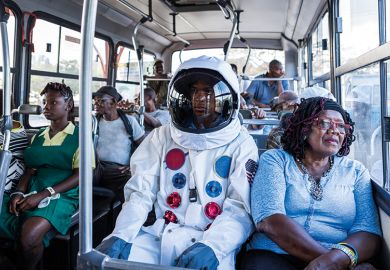Browse the full Times Higher Education World Reputation Rankings 2018 results
Move-in day” – that autumn day when first-year students arrive at their dorms at campuses across the world – represents a vibrant moment of social ritual and celebration.
On that day at Stanford University, the president, the provost and others like myself in senior leadership make a point of personally touring each dorm to welcome excited students and their loved ones. It is usually an emotional high for everyone.
In the next few days, however – after the fanfare of move-in, convocation, farewells – students walk into a bracing new reality.
We sometimes underestimate just what a profound shift this is: in addition to encountering a rigorous curriculum, students are expected to acclimatise to new physical and emotional environments, to navigate socio-economic, racial, gender and sexual differences, and to negotiate interpersonal and intellectual norms in this transition into college life.
These are often tacit, unspoken expectations – something that apart from perhaps a dorm workshop or two, students are frequently left to figure out more or less on their own.
To be sure, the heightened pressures that students face at university often have their origins in earlier experiences; more than 70 per cent of our incoming students confided in our pre-freshman survey that they felt overwhelmed in high school.
But based on what we have observed in recent years at Stanford and at other institutions, we have sought to rethink fundamentally the structure of our first year in ways that recognise and address these kinds of stressors. We are finding that these are not simply “student affairs” issues beyond the pale of curricular concerns; rather, they are directly related to the underpinning contexts making possible the most effective teaching and learning for incoming students. That is, the students’ experiences before and outside the classroom are directly connected to the business of the university.
What has become increasingly clear to me is that the first-year education, especially, needs to be more holistic, intentionally integrating the learning that happens both outside and within a class. We know that the first year is a unique and crucial window of time in a student’s whole development, and so we have launched initiatives – specifically keyed to those early months – based on the knowledge that students’ health and well-being have a great impact on the learning process.
For instance, I enlisted residential staff, students and social scientists with expertise in issues of belonging in educational environments to develop a targeted, research-based peer-to-peer programme, “Frosh 101”, that focuses on issues of belonging, identity and community in educational environments.
In autumn 2017, we piloted Frosh 101 with 97 students in five different first-year residences, working closely with trained student facilitators who led weekly 90-minute interactive sections consisting of 10 students each.
In our exit surveys of the pilot, 97 per cent of the students said that they would recommend Frosh 101 to other students. Significantly, 84 per cent reported that the course had helped them “very much” or “extremely” in understanding the viewpoints of students different from themselves. Frosh 101 encourages not only self-care and self-examination but also a consideration of others, of students’ social responsibility to their peers.
That attention to what university “community” means in practice has broader implications for peer-to-peer intervention, and we hope that such enhanced programming can increase students’ ethical engagement with others in their earliest days on campus.
Next autumn, we will increase the number of dorms to 10 and the number of students to about 300.
Frosh 101 draws on research that demonstrates that students’ identities and diverse experiences enable productive intellectual work and are not something to be merely “checked at the door”.
Some protest that attending to a student’s experiential point of view (racial, sexual, socio-economic and so on) is irrelevant to teaching and learning, and at worst a form of coddling antithetical to the academic enterprise.
But as many have argued before me, diversity brings excellence; it can introduce new perspectives and frameworks to intellectual projects. Notably, acknowledging differences enjoins institutions to change as well.
It is important to note, for instance, that more than 18 per cent of this year’s incoming Stanford class are first-generation, low-income students; this means that members of the freshman class come from decidedly different educational backgrounds – there will be those who have had no advanced-placement exams and those who have had upwards of 13.
Our evidence has shown that levels of stress, anxiety, depression and lack of a feeling of social belonging have been higher among low-income and/or first-generation students.
In another project, supported by the Diversity and First Generation Office in coordination with the vice-provost for teaching and learning, students created a powerful video, What I Wish My Professor Knew, documenting the biases that professors have perpetuated unknowingly – through case studies, book assignments, economic assumptions – and suggesting alternative approaches that would benefit learning.
Their video is a reminder that “diversity education” is multi-directional (students are not the only ones learning), and so Stanford is also actively working to scale faculty awareness at the individual and departmental level around issues of race, gender and class as they impact the faculty’s work, research and student interactions.
In fact, this year, for the first time in its history, the faculty senate conducted its own interactive diversity training session for its members, including the provost and the president, which also introduced colleagues to their own peers’ work on race and gender scholarship.
Of course, Frosh 101 and our increasing emphasis on student-faculty diversity education are only part of making the first year more responsive to the whole student. But we think it a crucial move towards creating conditions for curricular reforms for the first year that we are also undertaking, which include more experiential and active learning.
An imperative for us and other institutions is to pay more serious attention to the enormous reality shift that students undergo when entering university, a shift that can change both the students and, at times, the institutions they enter for the better.
The goal is, of course, not to spare students from all the stress or challenge of college, but rather, to make it possible for them to take and configure their place in our university community in service of why they come here in the first place: to learn.
Harry J. Elam is senior vice‑provost for education, vice‑president for the arts, and vice‑provost for undergraduate education at Stanford University.
POSTSCRIPT:
Print headline: A crucial first step
Register to continue
Why register?
- Registration is free and only takes a moment
- Once registered, you can read 3 articles a month
- Sign up for our newsletter
Subscribe
Or subscribe for unlimited access to:
- Unlimited access to news, views, insights & reviews
- Digital editions
- Digital access to THE’s university and college rankings analysis
Already registered or a current subscriber?







